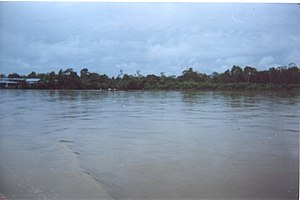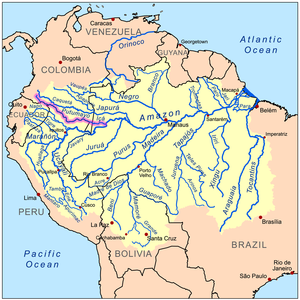Putumayo River
| Putumayo River Río Içá | |
|---|---|
 Putumayo at Puerto Asis, Colombia | |
 Map of the Amazon Basin with the Putumayo River highlighted in pink | |
| Location | |
| Countries | |
| Physical characteristics | |
| Source | Andes Mountains |
| • location | East of Pasto, Colombia |
| • coordinates | 1°07′23″N 77°03′22″W / 1.123°N 77.056°W |
| • elevation | 3,000 m (9,800 ft) |
| Mouth | Amazon River |
• location | Santo Antônio do Içá, Brazil |
• coordinates | 3°8′6″S 67°58′27″W / 3.13500°S 67.97417°W |
• elevation | 47 m (154 ft) |
| Length | 1,813 km (1,127 mi) to 2,004.6 km (1,245.6 mi)[1] |
| Basin size | 120,545 km2 (46,543 sq mi)[2] |
| Discharge | |
| • location | Santo Antônio do Içá (near mouth), Amazonas state, Brazil |
| • average | (Period: 1979–2015)8,519.9 m3/s (300,880 cu ft/s)[2] (Period: 1973–1990)8,760 m3/s (309,000 cu ft/s)[3] |
| Discharge | |
| • location | Tarapaca, Colombia (320 km upstream of mouth; Basin size: 108,362 km2 (41,839 sq mi) |
| • average | (Period: 1991–2020)7,588 m3/s (268,000 cu ft/s)[5] (Period: 1979–1993)7,034.6 m3/s (248,420 cu ft/s)[4] |
| • minimum | 2,054 m3/s (72,500 cu ft/s)[4] |
| • maximum | 12,522 m3/s (442,200 cu ft/s)[4] |
| Discharge | |
| • location | Puerto Leguízamo, Colombia (1,578 km upstream of mouth; Basin size: 20,616 km2 (7,960 sq mi) |
| • average | (Period: 1988–2011)1,859 m3/s (65,600 cu ft/s)[6] |
| Discharge | |
| • location | Puerto Asís, Colombia (1,890 km upstream of mouth; Basin size: 6,410 km2 (2,470 sq mi) |
| • average | (Period: 1988–2011)821 m3/s (29,000 cu ft/s)[6] |
| Discharge | |
| • location | Puente Texas, Colombia (Basin size: 3,544 km2 (1,368 sq mi) |
| • average | (Period: 1988– 2011)496 m3/s (17,500 cu ft/s)[6] |
| • minimum | 138 m3/s (4,900 cu ft/s)[7] |
| • maximum | 2,705 m3/s (95,500 cu ft/s)[7] |
| Basin features | |
| Progression | Amazon → Atlantic Ocean |
| River system | Solimões |
| Tributaries | |
| • left | Juanambu, Caucayá, Penella, Cara Paraná, Igara Paraná, Quebrada Mutún, Pupuña, Alegría, Igarapé Cauíra |
| • right | San Juan, Orito, Guamués, Cohembi, San Miguel, Güeppi, Campuya, Ere, Algodón, Yaguas, Cotuhé, Puretê, Paraná de Jacurapa |
The Putumayo River or Içá River (Spanish: Río Putumayo, Portuguese: Rio Içá) is one of the tributaries of the Amazon River, southwest of and parallel to the Japurá River.[8][9]
Course
[edit]The Putumayo River forms part of Colombia's border with Ecuador, as well as most of the border with Peru. Known as the Putumayo within these three nations, it is called the Içá when it crosses into Brazil. The Putumayo originates in the Andes Mountains east of the city of Pasto, Colombia. It empties into the Solimões (upper Amazon) near the municipality of Santo Antônio do Içá, Brazil. Major tributaries include the Guamués River, San Miguel, Güeppí, Cumpuya, Algodón, Igara-Paraná, Yaguas, Cotuhé, and Paraná de Jacurapá rivers.[8][10] The river flows through the Solimões-Japurá moist forests ecoregion.[11]
Tributaries
[edit]List of the major tributaries of the Içá–Putumayo (from the mouth upwards):[12]
| Left tributary | Right tributary | Length (km) | Basin size (km2) | Average discharge (m3/s) |
|---|---|---|---|---|
| Lower Putumayo | ||||
| Içá (Putumayo) | 2,004.6 | 120,545 | 8,519.9 | |
| Igarapé União | 634.2 | 35.8 | ||
| Quebrara Federico | 529.5 | 35.1 | ||
| Parana de Jacurapa | 352 | 1,714.6 | 105.3 | |
| Puretê | 322 | 4,246.7 | 249.9 | |
| Igarapé Cauíra | 1,459.7 | 94.3 | ||
| Igarapé São Cristovão | 406.4 | 22.1 | ||
| Cotuhé | 335 | 6,508.8 | 391.4 | |
| Yaguas | 474.9 | 10,863 | 683.2 | |
| Alegría | 731.5 | 49.4 | ||
| Rio del Porveir | 291.5 | 19.7 | ||
| Pupuña | 2,402.1 | 168.1 | ||
| Quebrada Mutún | 100 | 1,046.5 | 58.7 | |
| Igara Paraná | 440 | 12,945 | 810 | |
| Algodón | 749.8 | 8,268 | 454 | |
| Buri Buri | 983.4 | 46.3 | ||
| Esperanza | 557 | 24.6 | ||
| Sabaloyaco | 1,324 | 54.9 | ||
| Ere | 167 | 1,623.4 | 77 | |
| Middle Putumayo | ||||
| Cara-Paraná | 260 | 7,265.9 | 486.6 | |
| Campuya | 370 | 4,422.2 | 292.2 | |
| Curilla | 496.3 | 38.8 | ||
| Penella (Peneya) | 894.3 | 51.1 | ||
| Chicorero (Caucayá) | 1,720.9 | 97.5 | ||
| Quebrada La Paya | 572.3 | 33.2 | ||
| Güeppi | 145 | 1,325.5 | 91.4 | |
| San Miguel | 295 | 5,628.5 | 488.8 | |
| Juanambu | 811.1 | 71.3 | ||
| Cohembi | 543.7 | 45.1 | ||
| Upper Putumayo | ||||
| Guamués | 140 | 2,164.6 | 254.8 | |
| Acae (Cocaya) | 283.5 | 21.8 | ||
| Orito | 980.7 | 64.4 | ||
| San Juan | 918.6 | 62.6 | ||
| Guineo | 312.5 | 24.6 | ||
History
[edit]Exploration
[edit]In the late 19th century, the Içá was navigated by the French explorer Jules Crevaux (1847–1882). He ascended it in a steamship drawing 1.8 meters (6 ft) of water, and running day and night. He reached Cuembí, 1,300 km (800 mi) above its mouth, without finding a single rapid. Cuembí is only 320 km (200 mi) from the Pacific Ocean, in a straight line, passing through the town of Pasto in southern Colombia. Creveaux discovered the river sediments to be free of rock to the base of the Andes; the river banks were of argillaceous earth and the bottom of fine sand.
Rubber boom era
[edit]During the Amazon rubber boom of the late 19th and early 20th centuries, the land around the Putumayo became a major rubber-producing region, where Julio César Arana's Peruvian Amazon Company maintained a production network centered on the nearby city of Iquitos. His enterprise on the Putumayo was divided into two agencies, El Encanto one of which was on the Cara Paraná tributary and the other was La Chorrera on the Igara-Paraná. The latter's territory extended from the Igara-Paraná tributary of the Putumayo River to the Japurá River.[13]
Arana's production network mainly relied on the labor of enslaved indigenous people, who suffered from widespread human rights abuses. These abuses were first publicized in 1909 within the British press by the American engineer Walter Hardenburg, who had been briefly imprisoned by Arana's private police force in 1907 while visiting the region; Hardenburg later published his book The Putumayo: The Devil's Paradise in 1913.[14]
In response to Hardenburg's exposé, the British government sent the consul Roger Casement (who had previously publicized Belgian atrocities in the rubber business of the Congo Free State) to investigate the matter; between 1910 and 1911, Casement subsequently wrote a series of condemnatory reports criticizing the atrocities of the PAC, for which he received a knighthood.[15]
Casement's reports later formed much of the basis for the 1987 book Shamanism, Colonialism, and the Wild Man by the anthropologist Michael Taussig, which analyzed how the acts of terror committed by British capitalists along the Putumayo River in Colombia had created a distinct "space of death."
Modern-day
[edit]Today, the river is a major transport route. Almost the entire length of the river is navigated by boats.[10]
Cattle farming, along with the rubber trade, is also a major industry on the banks of the Içá. Rubber and balatá (a substance very much like gutta-percha, to the point where it is often called gutta-balatá) from the Içá area are shipped to Manaus, Brazil.
On March 1, 2008, Raúl Reyes and 14 of his fellow Revolutionary Armed Forces of Colombia guerrilla companions were killed while on the Ecuadorian side of the border by Colombian military forces, sparking the 2008 Andean diplomatic crisis.[16]
In November 2019, scientists from the Field Museum worked with partners from Colombia and Peru to perform a three-week "rapid inventory" of almost 7 million acres around the Putumayo, one of the few Amazonian rivers that remains undammed, documenting 1,706 species.[17] The goal of these fast surveys of remote areas is to bring together local stakeholders to collaboratively protect wilderness.[18]
As of June 2024[update], the British government warns against "all but essential travel" to some areas within 20 kilometres (12 mi) to the south of the river.[19]
References
[edit]- ^ Perú: Anuario de Estadistícas Ambientales 2022 (PDF). 2022.
- ^ a b "Archived copy" (PDF). meioambiente.am.gov.br. Archived from the original (PDF) on 2021-05-06. Retrieved 2021-10-03.
{{cite web}}: CS1 maint: archived copy as title (link) - ^ Théry, Hervé; Maurence, Pascale (1997). HYDROLOGIE DU BASSIN AMAZONIEN (PDF). ISBN 2-7011-1532-9.
- ^ a b c "Amazon Basin-Station: São Paulo de Olivença".
- ^ ESTUDIO NACIONAL DEL AGUA 2022 (PDF). 2023. ISBN 978-958-5489-12-7.
- ^ a b c ESTUDIOS DE FASE II PARA LA NAVEGABILIDAD DEL RÍO PUTUMAYO (PEÑASORÁ – PTO. ASÍS – PTO. LEGUÍZAMO – PTO. ALEGRÍA). 2016.
- ^ a b "3.2 Recursos hídricos".
- ^ a b Ziesler, R.; Ardizzone, G.D. (1979). "Amazon River System". The Inland waters of Latin America. Food and Agriculture Organization of the United Nations. ISBN 92-5-000780-9. Archived from the original on 8 November 2014.
- ^ "Informações do Rio Içá" (in Portuguese). Brasilia, Brazil: Brazilian Ministry of Transport. 2014. Archived from the original on 2013-07-02. Retrieved 2015-01-10.
- ^ a b "Putumayo River". Encyclopædia Britannica. Encyclopædia Britannica Inc. 2015. Retrieved 2015-01-10.
- ^ Sears, Robin; Marín, César, Northern South America: northwestern Brazil, southern Colombia, and northern Peru (NT0163), WWF: World Wildlife Fund, retrieved 2017-03-26
- ^ "Putumayo".
- ^ Hardenburg, Walter (1912). The Putumayo, the Devil's Paradise; Travels in the Peruvian Amazon Region and an Account of the Atrocities Committed Upon the Indians Therein. T. F. Unwin, 1912. p. 181.
- ^ Mann, Charles (2012). 1493: Uncovering the New World Columbus Created. Vintage Books. pp. 330–333. ISBN 9780307278241.
- ^ Fintan O'Toole, "The Multiple Hero", The New Republic, 2 August 2012, accessed 23 October 2014
- ^ Abatido ‘Raúl Reyes’
- ^ "Protecting One of the Amazon's Last Free-Flowing Rivers". Field Museum of Natural History. 22 April 2020. Retrieved 19 November 2021.
- ^ Vriesendorp, Corine (9 March 2011). "Rapid Inventories". Field Museum of Natural History. Retrieved 19 November 2021.
- ^ Foreign, Commonwealth and Development Office, Foreign travel advice: Peru, accessed on 18 June 2024
External links
[edit]- . Collier's New Encyclopedia. 1921.
- Hardenburg, W.E. 1913. The Putumayo: The Devil's Paradise—Travels in the Peruvian Amazon Region and An Account of The Atrocities Committed Upon the Indians Therein. London: T. Fisher Unwin. https://archive.org/details/putumayodevilspa00hardrich
- "Safeguarding the Putumayo-Iça River Basin". IW:Learn. 27 March 2024. Retrieved 1 April 2024.
